A data-driven future
CVM researchers are using banks of genetic data to drive the next frontier of veterinary medicine

CVM researchers are using banks of genetic data to drive the next frontier of veterinary medicine
Genetic data can tell stories no other information can.
Locked in helices of DNA and RNA are imprints that make an animal unique. The exact hue of a cat’s fur, the shape of a dog’s body, and whether or not the animal’s genes predict disease.
University of Minnesota (UMN) College of Veterinary Medicine (CVM) researchers are utilizing troves of biodata to advance how we predict disease, to develop tests and design novel treatments, and to track viruses as they mutate.
“We have access to these amazing datasets that can be mined for different things,” says Peter Larsen, PhD, an assistant professor in the Department of Veterinary and Biomedical Sciences and co-director of the Minnesota Center for Prion Research and Outreach (MNPRO). “In the old way of doing things, you had one biological question and you generated data for that single question. The new way is you’ve generated an enormous amount of data for an initial question, but here are five others you can address with the same data.”
Databanks become even more powerful when researchers from different fields join forces.
Larsen is part of a collaborative team of UMN researchers using portable sequencing technology called the Oxford Nanopore MinION to identify new tick-borne viruses. The speed and size of the technology is a game-changer for discovery in the field.
“The sequencer is the size of a Snickers bar and it’s revolutionizing genetic sequencing. We’ve deployed it in the jungles of Borneo, Madagascar, and the Amazon to be able to sequence DNA in the field, in real-time,” Larsen says.
To identify emerging tick-borne diseases, Larsen and a group of researchers from CVM and the UMN School of Public Health, including tick and vector-borne disease expert Jon Oliver, will conduct fieldwork in an unassuming place: Central Kansas.
“The ecology of Central Kansas is very diverse and because of that, the rodent diversity is high, which also makes it a predicted hotspot for tick-borne pathogens,” he says.
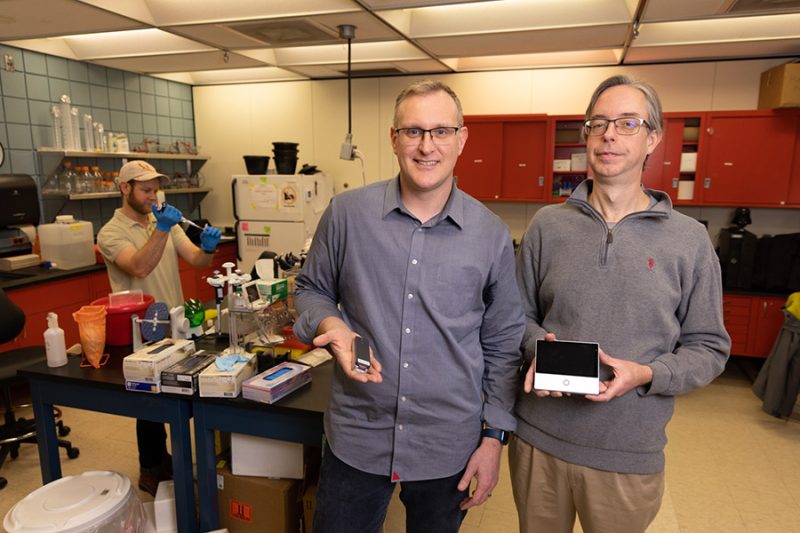
Ixodid ticks—a family of hard ticks that carry viruses and other pathogens that infect animals and humans—are hosts to at least seven known zoonotic pathogens, and Larsen and his team are using smaller, faster technology to identify new pathogens lingering in the arachnids’ virome.
“We can perform deep viral sequencing, which means you can characterize all the viruses present in a tick at the same time using the nanopore sequencer,” he says. “It opens the door to discovery in ways that were impossible before.”
By identifying viruses that had previously gone undetected, the researchers can inform medical teams about potential causes of illness that may not be showing up on clinical tests.
“If clinicians see patients that have symptoms that are consistent with a tick-borne illness, but traditional diagnostics fail and they don’t know what is causing the illness they might consider testing for the new viruses that were discovered as a result of our research,” Larsen says.
With funding from the Office of the Vice President for Research (OVPR), CVM experts are building a Veterinary Biobank housed in the Veterinary Clinical Investigation Center (CIC). The biobank will be the sixth cancer-focused biobank at the University, and the only one focused on veterinary samples. The five others are managed by the Masonic Cancer Center (MCC) and house samples from humans.
The partnership between the MCC and CVM has yielded huge strides in both animal and human cancer medicine. The new, animal-focused biobank will allow researchers from both sides to utilize genetic data to study common cancers that affect both pets and humans.
The CIC’s director, Dr. Antonella Borgatti, says the biobank will first focus on collecting samples from dogs with cancer cells called hematologic malignancies, and then expand to other diseases that show up in similar ways in both humans and their pets.
“We selected hematologic malignancies as our starting point because these tumors arise commonly in both humans and dogs,” says Borgatti, noting the resource will provide bigger opportunities for collaborative research.
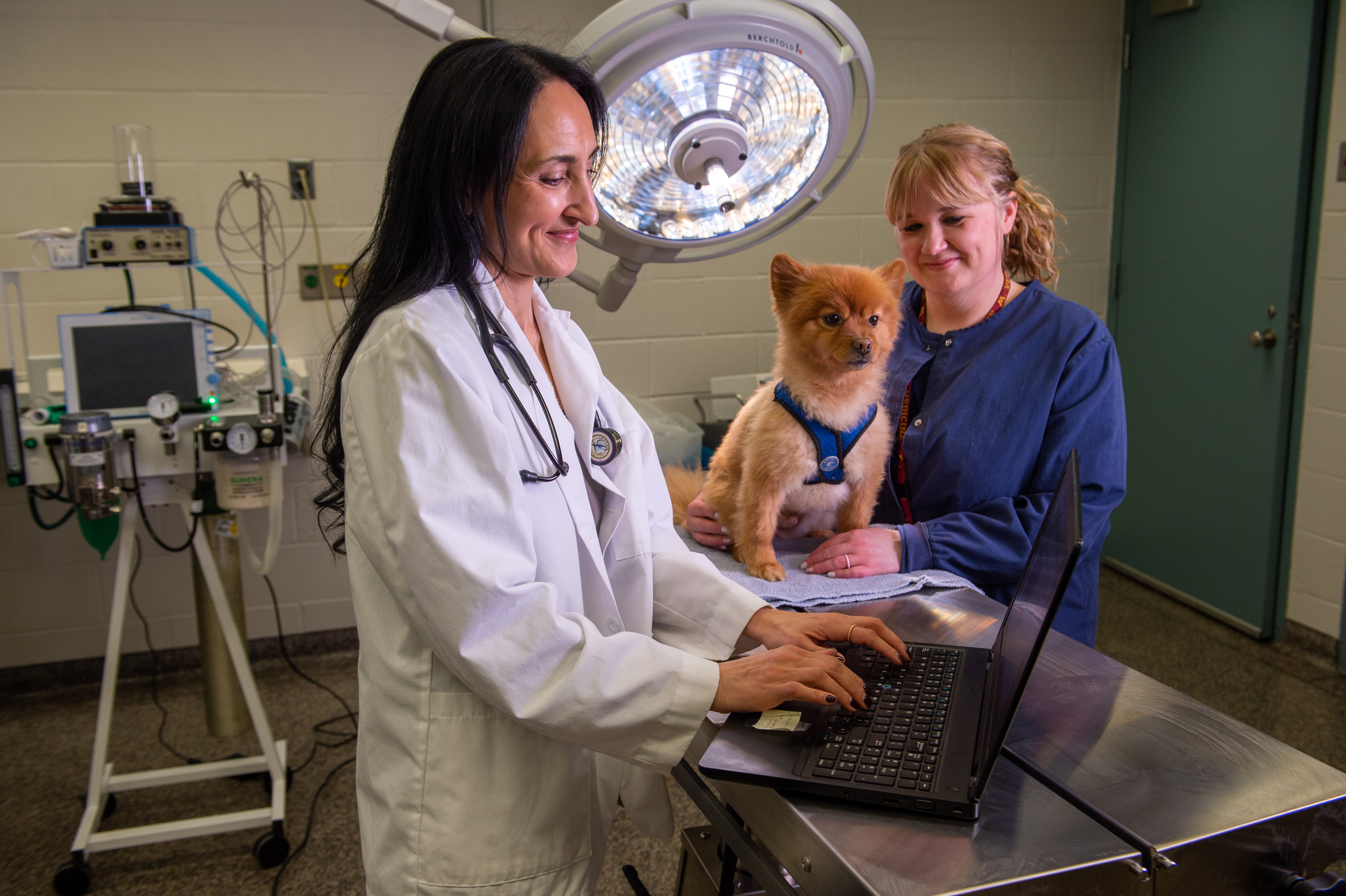
The biobank is in the initial phases of being built, but CVM researchers are already thinking carefully about which samples will make the cut.
“We’re trying to be thoughtful and careful about the type of samples we are collecting because we want to make sure the samples we’re storing will be useful,” Borgatti says.
The samples will include blood, bone marrow, and tissue samples that investigators from different areas of expertise will be able to utilize in unique ways, including to develop new biomarkers and cancer therapies.
The OVPR funding also went to a second data-focused project.
The VMC medical record system has logged mounds of health data, and while the system works well in the hospital, the data cannot be easily offloaded for use in research. To make these data available to researchers, the health science technology team is helping Borgatti and her team create a searchable database called the Veterinary Data Repository.
“It will transform the medical information that is available in these vet patient records into scientific data that can enable research and inform new inquiries,” she says.
Dr. Eva Furrow, a faculty member in the Canine Genetics Lab and co-director of the Minnesota Urolith Center, works as part of a team that has utilized the center’s 1.5 million urolith samples to pinpoint a genetic mutation that causes juvenile kidney and bladder stones in some dog breeds.
Calcium oxalate urinary stones are rare in young breeds but become more common as dogs age. Most cases, and therefore genetic samples, come from middle-aged and older dogs. Overall, only about 2 percent of samples submitted to the Minnesota Urolith Center come from young dogs, the team’s target demographic. Of those, an even smaller portion came from dogs that formed kidney stones.
“But because we have so much data in the Minnesota Urolith Center, even looking at 2 percent is a lot of data,” Furrow says. Despite such narrow parameters, their search yielded 500 recent calcium oxalate samples that matched their criteria. “Those numbers were enough for us to recognize patterns present in juvenile stone formers, and we would only be able to achieve this with such a massive database,” she says.
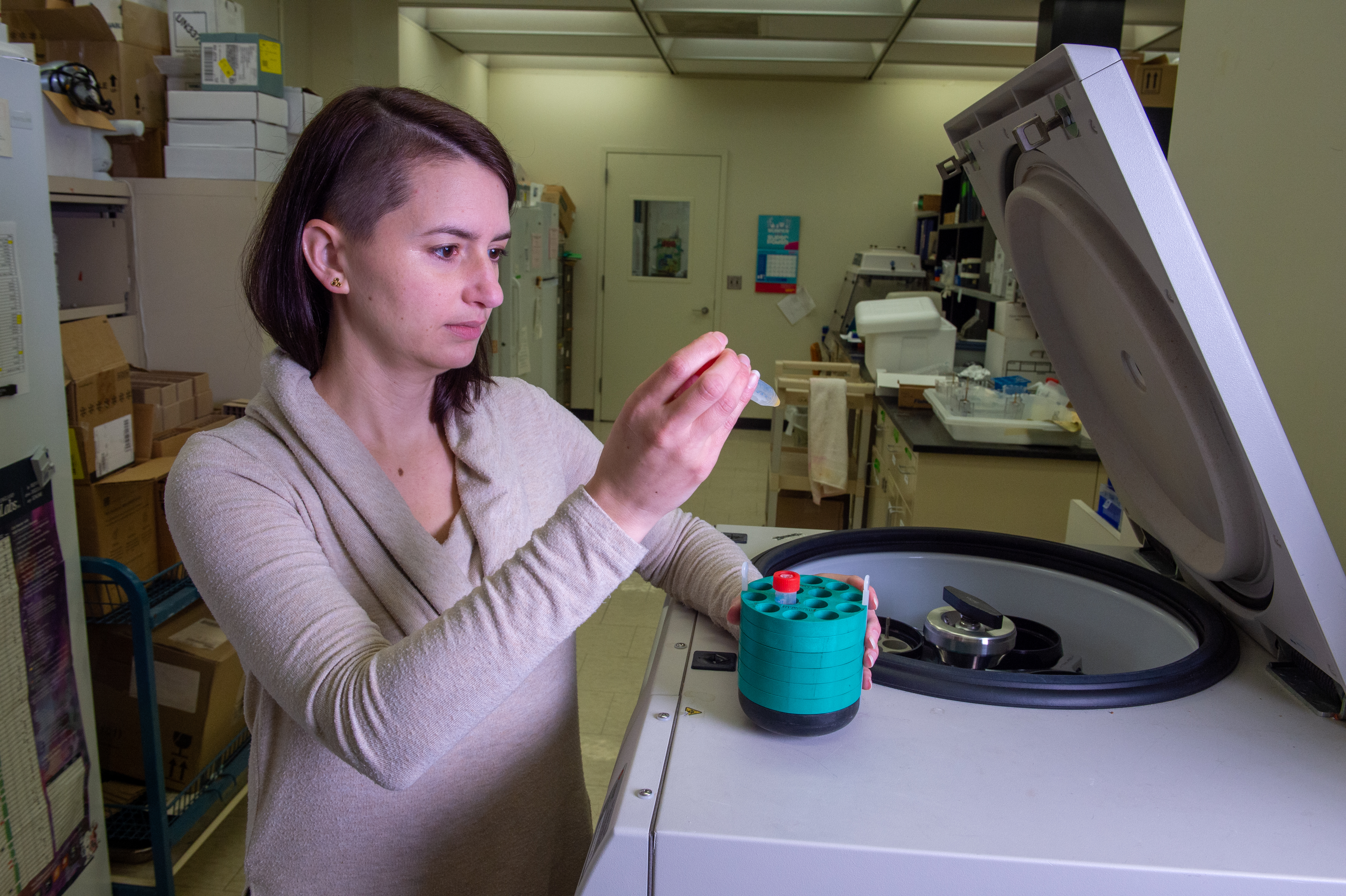
One of those patterns was related to the breeds the stones usually impact. Calcium oxalate stones are common in dogs in general, and some breeds, such as bichon frisés or schnauzers, are at particularly high risk. But the team repeatedly found French and English bulldogs and pugs that were juvenile stone formers. The team sorted through millions of genetic variants, or mutations, and landed on just one that was strikingly associated with very young dogs forming stones––something that usually doesn’t happen until a dog is older.
While this one mutation was most common in the English bulldogs with calcium oxalate stones, they also found it popping up in additional breeds. In total, they identified seven other breeds in which having the mutation directly predicted urinary stones at a young age.
As the team started screening dogs for the mutation, they discovered that some young bulldogs had a second genetic mutation.
“Together, those two mutations explain about 90 percent of calcium oxalate stones in bulldogs,” she says. The second mutation was later found to be also present in at least five other breeds.
Identifying the variants informs treatment and helps veterinarians understand which medications will likely work in which dogs without having to guess and check.
“It moves us towards precision medicine,” Furrow says.
Despite being bred to be athletes, roughly half of all healthy racehorses have an irregular heartbeat when exercising.
The Equine Genetics and Genomics Laboratory houses 14,000 DNA and tissue samples from horses around the world, including many from thoroughbred racehorses.
“If there is a breed, we’ve probably got DNA from it,” says Dr. Sian Durward-Akhurst, an assistant professor of genetics, genomics, and large animal internal medicine in the Department of Veterinary Clinical Sciences.
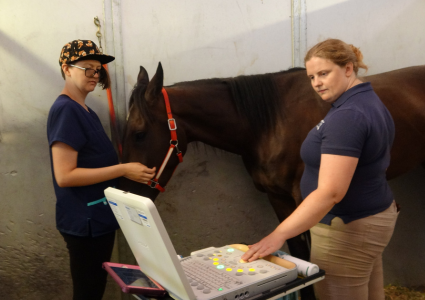
The bank currently houses 550 samples from horses that have been evaluated for cardiac arrhythmias and aims to amass 1,200 total. Durward-Akhurst is part of a team that’s using the bank of genetic data to identify genes that predispose some racehorses not only to arrhythmias but to cardiac arrest and sudden death due to the condition.
Currently, all genetic discovery in horses relies on one fully sequenced genome, from a mare named Twilight, who lives at Cornell University. But only having one genome to reference can mask variation.
“If both Twilight and another horse have a variant that causes disease, we’re not going to catch it because they’re the same,” Durward-Akhurst says. “But by relying on a big dataset, we can use whole genome sequencing on a large number of individuals, to give us a picture of what is going on in the population.”
Once UMN researchers identify key genetic variants, “It won’t be as simple as we will never breed certain horses together,” says Durward-Akhurst, noting that there are several reasons, including the impracticality of removing thoroughbred racehorses from the breeding pool, especially closed-book studs. “Most diseases are also not caused by one gene, but rather by a combination of genes. But understanding which horses carry specific genes can give us a genetic risk score.”
Armed with that knowledge, veterinarians can more closely monitor horses with mutations in certain genes that put them at higher risk for sudden death during training or a race.
The UMN’s massive collections of data are also informing farming, and how producers can manage some of the most insidious diseases facing livestock.
“The Veterinary Diagnostics Lab does a great deal of diagnostic work for the swine industry to detect and monitor infectious diseases. All of this information sits in databases, and the accumulation of that over many years becomes a huge data resource for research,” says Kimberly VanderWaal, PhD, an associate professor in the Department of Veterinary Population Medicine (VPM).
She and her team have zeroed in on Porcine Reproductive and Respiratory Syndrome (PRRS), which is considered to have the largest impact on pig production. The RNA virus that causes the disease is extremely good at mutating, and when a new outbreak emerges, sequenced samples from infected pigs hold clues about what strain of PRRS a farm has and where the infection came from. The virus is one of the most sequenced in the world––SARS-CoV-2 is the most sequenced––and the VDL generates about 1,000 different sequences for PRRS every year.
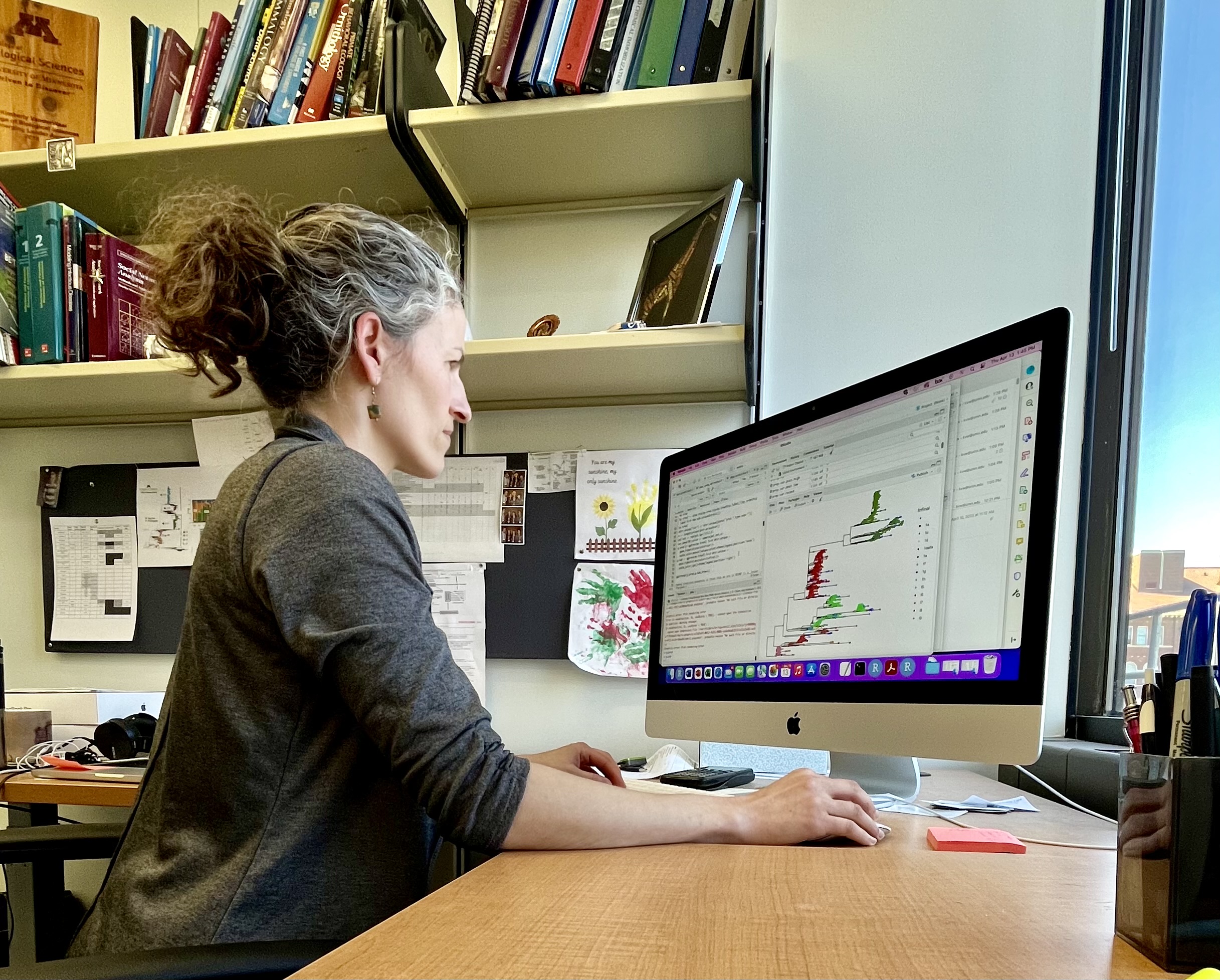
“Having so much data allows us to take a 30,000-foot look at what has been going on with the virus’s evolution over the past 20 years,” says VanderWaal.
Researchers have been able to track the virus as it mutates, logging how different lineages have ebbed and flowed over time. Just as it’s critical for public health experts to understand how SARS-CoV-2 is changing over time, getting a genetic snapshot of how PRRS has behaved over the past two decades is imperative to keeping the virus at bay.
“The most concerning part of this is how dynamic the situation is in the field, with newly evolved variants sometimes showing epidemic-like spread. There’s a lot of turnover of which lineages are going around,” VanderWaal says.
The data also shows that the virus's RNA is evolving in places that could allow it to evade immunity in vaccinated or previously infected pigs. Understanding when and where the virus is changing can inform vaccines that better match circulating strains—but it’s still a tricky task.
“Part of the question is how different can two PRRS viruses be before infection with one strain is not enough to protect against another anymore,” VanderWaal says. “Keeping up with the current strain really is a moving target, but utilizing data to look at the virus in an aggregate way allows us to start to see things differently.”